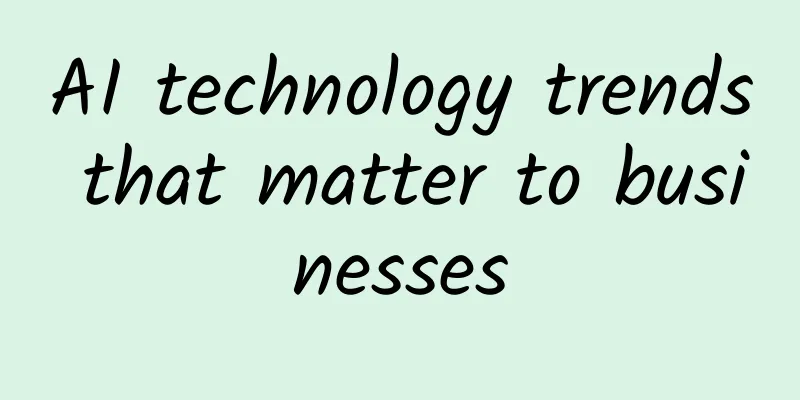AI technology trends that matter to businesses

|
According to the 2020 McKinsey Global Artificial Intelligence (AI) Survey, more than 50% of companies have adopted AI in at least one business unit or function in 2020, so we are witnessing the emergence of new AI trends. Organizations apply AI tools to create more value, increase revenue and customer loyalty. AI leaders invest at least 20% of their earnings before interest and taxes (EBIT) in AI. This number is likely to increase as COVID-19 accelerates digitalization. The lockdown has led to a surge in online activities and a large-scale adoption of AI in business, education, administration, social and more.
This article aims to outline the new and current trends in artificial intelligence that emerged in 2020 and are still growing in 2021. Enterprises can predict the future of artificial intelligence in 2022 based on the trends and successfully reduce risks. AI Adoption TrendsThe level of AI adoption varies by industry. Using data from McKinsey’s Global AI Survey, we can highlight four leading industries: high-tech, telecommunications, automotive, and assembly. Companies apply AI to service operations, service or product design, advertising, and sales. In terms of investment, the field of drug discovery and development received the most funding - in 2020, total assets exceeded US$13.8 billion, a 4.5-fold increase from the previous year. AI will drive the highest revenue growth if applied to inventory and parts optimization, pricing and promotions, customer service analytics, and sales and demand forecasting. Use cases reporting cost reductions are related to optimizing talent management, contact center automation, and warehouse automation. Artificial Intelligence Technology TrendsIn 2021 and the following years, AI will be used to streamline operations and improve efficiency. Enterprises should try to benefit from the business applications of AI by improving IT infrastructure and data management. But not every deployed AI model can be helpful to the company and suitable for performance monitoring. We will focus on the 2021-2022 AI trends that are likely to become mainstream. Trend 1: AI for security and surveillanceArtificial intelligence technologies are already being used for face recognition, voice recognition, and video analysis. These technologies form the best combination for surveillance. Therefore, by 2021, we can expect a lot of utilization of artificial intelligence in video surveillance. Artificial intelligence facilitates flexible setup of security systems. Previously, engineers spent a lot of time configuring the system so that it would be activated when a certain number of pixels on the screen changed. As a result, there were too many false alarms. These alarms were caused by falling leaves or running animals. Thanks to artificial intelligence, security systems can recognize objects, which facilitates more flexible setup. AI in video surveillance can detect suspicious activity by focusing on unusual behavioral patterns rather than faces. This capability can create safer public and private spaces by identifying potential threats. Such AI-driven video solutions may also help in logistics, retail, and manufacturing. Another niche that offers promise for AI applications is voice recognition. Technologies related to voice recognition can determine identity. Identity refers to a person’s age, gender, and emotional state. The principles underlying voice recognition for surveillance are likely the same as in the case of Alexa or Google Assistant. One feature that applies to security and surveillance is the built-in anti-spoofing model that detects synthesized and recorded speech. One of the most critical security technologies is biometric face recognition. Different malicious applications try to fool security systems by providing fake photos instead of real images. To protect against this, multiple anti-spoofing technologies are currently being developed and used on a large scale. Trend 2: Artificial Intelligence in Real-Time Video ProcessingThe challenge of processing live video streams is handling the data pipeline. Engineers’ goal is to ensure accuracy and minimize latency in video processing. AI solutions can help achieve this. To implement an AI-based approach in real-time video processing, we need a pre-trained neural network model, a cloud infrastructure, and a software layer for applying user scenarios. Processing speed is critical for real-time streaming, so all these components should be tightly integrated. For faster processing, we can parallelize the process or improve the algorithm. Process parallelization is achieved by file splitting or using a pipeline approach. This pipeline architecture is the best choice because it does not reduce the accuracy of the model and allows real-time processing of videos using AI algorithms without any complexity. In addition, for the pipeline architecture, additional effects that imply face detection and blur can be applied. Modern live stream processing is inseparable from the application of background removal and blurring. The demand for these tools has increased as COVID-19 has contributed to the emergence and popularity of new trends in video conferencing. These trends will develop positively as the global video conferencing market is expected to grow from $9.2 billion in 2021 to $22.5 billion in 2026, according to GlobeNewswire. There are multiple approaches to developing tools for background removal and blurring in real-time videos. The challenge is to design a model that can separate a person in a frame from the background. Neural networks that can perform such tasks can be based on existing models such as BodyPix, MediaPipe, or PixelLib. After choosing a model, there remains the challenge of integrating it with an appropriate framework and organizing the best execution through an application with WebAssembly, WebGL, or WebGPU. Trend 3: Generative AI for content creation and chatbotsModern AI models can generate text, audio, and images of very high quality that is nearly indistinguishable from non-synthetic, accurate data. At the core of text is Natural Language Processing (NLP). The rapid development of NLP has led to the emergence of language models. For example, Google and Microsoft have successfully used the BERT model to supplement their search engines. How else can the development of NLP-related technologies drive company growth? First, combining NLP and AI tools allows for the creation of chatbots. According to Business Insider, the chatbot market is expected to reach $9.4 billion by 2024, so let’s highlight the ways businesses can benefit from AI-driven chatbot implementations. Chatbots try to understand people’s intentions rather than just executing standard commands. Companies working in different fields use AI-driven chatbots to provide human-level communication to their customers or users. The application of chatbots is widely used in the following business sectors: healthcare, banking, marketing, travel, and hospitality. AI-driven chatbots help automate administrative tasks. For example, in the healthcare sector, they reduce manual labor. Here, chatbots help schedule appointments, send reminders related to medication, and provide answers to patients' questions. In other sectors, chatbots are introduced to deliver targeted messages, improve customer engagement and support, and provide personalized services to users. Besides chatbots, NLP is at the core of other cutting-edge technology solutions. One example is NLP text generation that can be used for business applications. The recently launched GPT-3 model has enabled AI engineers to generate an average of 4.5 billion words per day. This will enable a large number of downstream applications of AI for both socially beneficial and less valuable purposes. This has also prompted researchers to invest in techniques to detect generative models. Note that in 2021-2022, we will witness the arrival of GPT-4 — “Artificial General Intelligence AI.” Coming back to generative AI, we want to focus on GANs, or Generative Adversarial Networks, which are able to create images that are indistinguishable from artificially generated ones. This could be images of non-existent people, animals, objects, and other types of media such as audio and text. Now is the perfect time to implement GANs to unleash their capabilities. They can model real data distributions and learn useful representations to improve AI pipelines, secure data, spot anomalies, and adapt to specific real-world cases. Trend 4. AI-driven QA and inspectionThe most notable branch of computer vision is AI inspection. This direction has been booming in recent years due to the improved accuracy and performance of applied deep learning models. Companies began to invest computing and financial resources to develop computer vision systems at a faster pace. Automated inspection in manufacturing means analyzing whether a product meets quality standards. This approach also applies to equipment monitoring. Here are a few use cases for AI detection:
Trend 5: Disruptive AI Breakthroughs in HealthcareThe next trend related to the implementation of AI in the healthcare industry has been widely discussed in recent years. Scientists use AI models and computer vision algorithms to fight COVID-19 in areas including pandemic detection, vaccine development, drug discovery, thermal screening, facial recognition with masks, and analyzing CT scans. To counteract the spread of COVID-19, AI models can detect and analyze potential threats and make accurate predictions. Additionally, AI helps in the development of vaccines by identifying the key components that make them effective. AI-driven solutions can be used as effective tools on the Internet of Medical Things and deal with confidentiality issues specific to the healthcare industry. If we systematize AI use cases in healthcare, it is clear that their goals are consistent - ensuring fast and accurate diagnosis of patients. Trend 6: No-code AI platforms in at least three areasNo-code AI platforms enable even small companies to apply powerful technologies that were previously available only to large enterprises. Let’s find out why such platforms are a key AI trend for enterprises in 2021. Developing AI models from scratch requires time, expense, and experience. Adopting a no-code AI platform simplifies the task because it lowers the barrier to entry. The advantages are:
Healthcare, the financial sector, and marketing all need no-code AI platforms — even though the resulting solutions are not highly customizable. Among the most popular no-code AI platforms, you can find Google Cloud Auto ML, Google ML Kit, Runaway AI, CreateML, MakeML, SuperAnnotate, and others. Enterprise-scale companies and mid-sized businesses use the no-code platform to develop software solutions designed for image classification, gesture and sound recognition, and object detection. The evolution and future of artificial intelligenceTrends indicate a promising future for AI as AI solutions are becoming commonplace. Self-driving cars, robots and sensors for predictive analytics in manufacturing, virtual medical assistants for media coverage, NLP for media coverage, virtual tutors for education, AI assistants and chatbots that can replace humans in customer service – all these AI-driven solutions are taking a big step forward. |
<<: This article explains OSPF clearly.
>>: Why are operators trying so hard to promote 5G packages?
Recommend
Why is Web 3.0 important? What are the basics you need to know?
Editor's Note: What is Web 3.0? How does it d...
An article to help you understand HTML5 MathML
[[347913]] HTML5 can use MathML elements in docum...
Breaking the shackles of proprietary systems: the open path to 5G networks
As technology continues to change, the era of pro...
Summary information: PIGYun/Lisa Host/Vmshell/CoNoov/Vollcloud/KuaiKuai Network/LiuLiu Cloud/Yitan Cloud/Yunmi Technology
Recently, we have received a lot of product or pr...
TNAHosting: 500GB hard drive VPS from $4 per month, 4GB memory VPS from $4 per month
TNAHosting recently held a Happy Near Year event,...
Thinking about the Boundary Expansion of Web Front-end in the 5G Era
Author: Wang Shuyan and Wang Jiarong, Unit: China...
Five-minute technical talk | Understand how computers send and receive information in one article
Part 01 Physical Layer If a computer wants to tra...
Four major trends in China's Internet development
On April 20, 1994, China gained full access to th...
The unlimited package that people love and hate is going to be cancelled
[[272811]] The "unlimited data" package...
HostYun newly launched China Unicom AS9929 premium line with high configuration, KVM architecture, 1G memory package with monthly payment starting from 25 yuan
HostYun (host cloud, the original domain name hos...
What to do if you forget your router password? Do it yourself without asking for help
Now we are in the Internet age, the Internet make...
OpLink: Houston 1Gbps unlimited traffic high-security VPS starting at $1 for the first month
Tribe has shared information about OpLink twice i...
5G NB-IOT Billion Journey Online Industry Summit was held online. "New Infrastructure New IoT" opens up new opportunities
[51CTO.com original article] On April 15, 2020, t...
What are the short-range wireless communication technologies?
Wireless communication technology has taken off i...
How edge computing, edge networking, and edge data management work together
Edge computing, edge networking, and edge data ma...









